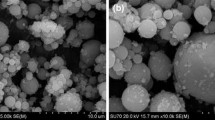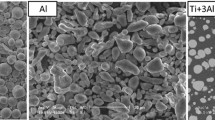Abstract
The phase, dispersive, and morphological features of an aluminum oxide powder produced by explosive synthesis are examined experimentally. It is shown that the particle-size distribution has three distinct maxima, which are due to different combustion regimes. The relationship between the sizes and morphology of the starting powder and the product is determined. Considerable attention is given to a study of the ultrafine fraction of the product powder. The ultrafine particles are shown to have a regular spherical shape, and sinters are not revealed. Besides spherical particles, the synthesized powder contains faceted crystals. X-ray phase analysis of the ultrafine fraction of the synthesized powders shows that this fraction consists only of the metastable phases of the oxide — the δ- or oxynitride modifications. The δ-modification differs from that described in the literature.
Similar content being viewed by others
References
I. D. Morokhov, L. I. Trusov, and V. N. Lapovok,Physical Phenomena in Highly Disperse Media [in Russian], Énergoatomizdat, Moscow (1984).
M. I. Aivazov, V. V. Volod’ko, et al., “Forms of growth of ultrafine powders in plasmachemical reactors,”Poroshk. Metall., No. 1, 1–5 (1981).
Yu. A. Kotov and N. A. Yavorskii, “Particles produced by electrical explosion of conductors,”Fiz. Khim. Obrab. Mater., No. 4, 24–29 (1978).
F. Pokhil, A. F. Belyaev, et al.,Combustion of Metal Powders in Reactive Media [in Russian], Nauka, Moscow (1972).
A. G. Beloshapko, A. A. Buakemskii, and A. M. Staver, “Formation of ultradisperse compounds by shock-wave loading of porous aluminum. Investigation of the particles produced,”Fiz. Goreniya Vzryva,26, No. 4, 93–98 (1990).
A. A. Buakemskii, “Production of new ultradisperse materials and investigation of their properties,” Candidate’s Dissertation in Phys.-Math. Sci., Krasnoyarsk (1995).
P. A. Kouzov,Fundamentals of the Analysis of the Grain-Size Composition for Commercial Dusts and Ground Materials [in Russian], Khimiya, Leningrad (1974).
J. E. Bonevich and L. D. Marks, “The sintering behavior of ultrafine alumina particles,”J. Mater. Res.,7. No. 6, 1489–1500 (1992).
S. N. Kul’kov, V. F. Nesterenko, M. P. Bondar’, et al., “Explosion activation of quench-hardened ZrO2 Y2O3 ceramic submicron powders,”Fiz. Goreniya Vzryva,29, No. 6, 66–72 (1993).
A. G. Beloshapko, A. A. Bukaemskii, I. G. Kuz’min, and A. M. Staver, “Dynamic synthesis of zirconium dioxide powders,”Fiz. Goreniya Vzryva,29. No. 6, 78–81 (1993).
V. P. Grachukho, A. M. Stepanov, and A. A. Khvatsev, “Estimation of the dispersity of metal particle combustion products,”Fiz. Goreniya Vzryva,12, No. 4, 519–530 (1976).
G. I. Smelkov, A. A. Aleksandrov, V. A. Pekhotikov, and E. V. Grishin, “Combustion of large aluminum particles in an air flow,”Fiz. Goreniya Vzryva,14, No. 5, 33–37 (1978).
V. A. Arkhipov, V. A. Ermakov, and A. A. Razdobreev, “Dispersity of condensed products of combustion of an aluminum drop,”Fiz. Goreniya Vzryva,18, No. 2, 16–19 (1982).
M. E. Derevyaga, L. N. Stesik, and É. A. Fedorin, “Magnesium combustion regimes,”Fiz. Goreniya Vzryva,14, No. 5, 3–10 (1978).
A. G. Beloshapko and A. A. Bukaemskii, “Shock adiabat of highly porous aluminum,” in:Treatment of Materials by Pulsed Loading (collected papers), Novosibirsk (1990), pp. 19–21.
B. C. Lippens and J. J. Steggerda, “Active aluminum oxide,” in: B. G. Linsen et al. (eds.),Physical and Chemical Aspects of Adsorbents and Catalysts, Academic Press, London-New York (1970).
P. P. Budnikov, I. A. Bulavin, et al.,New Ceramics [in Russian], Stroiizdat, Moscow (1969).
G. V. Samsonov, O. P. Kulik, and V. S. Polishchuk,Production and Methods of Analysis of Nitrides [in Russian], Naukova Dumka (1978).
Author information
Authors and Affiliations
Additional information
Translated fromFizika Goreniya i Vzryva, Vol. 36, No. 5, pp. 119–125, September–October, 2000.
This work was supported by the INTAS Foundation (Grant No. 97-1754).
Rights and permissions
About this article
Cite this article
Bukaemskii, A.A., Beloshapko, A.G. & Puzyr’, A.P. Physicochemical properties of Al2O3 powder produced by explosive synthesis. Combust Explos Shock Waves 36, 660–666 (2000). https://doi.org/10.1007/BF02699530
Received:
Issue Date:
DOI: https://doi.org/10.1007/BF02699530




